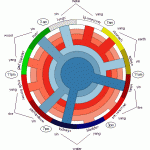 An ancient Chinese adage says: ‘A tree grows from the roots.’ Yin and Yang and the Five Elemental Energies form the main roots in the Taoist tree of health, and the entire edifice of traditional Chinese medicine and physiology is based upon the foundation of these energy principles.
An ancient Chinese adage says: ‘A tree grows from the roots.’ Yin and Yang and the Five Elemental Energies form the main roots in the Taoist tree of health, and the entire edifice of traditional Chinese medicine and physiology is based upon the foundation of these energy principles.
The Five Elemental Energies and their cycles provide a practical working model through which the interrelationships between the human body and the natural environment may be understood and controlled. They also illuminate the internal functional relationships between the body’s various vital organs and explain how external elements such as foods and medicinal herbs influence the organs and their functions. All aspects of human health, including physiology and pathology, diagnosis and therapy, are rooted in this remarkably reliable system of polar forces and cyclic energy transformations.
The traditional Chinese view of human physiology differs significantly from the Western view in that the Chinese have always focused attention on the function rather than the form of the vital organs. The Western medical practice of studying human physiology based upon anatomical locations of various organs as revealed in dissected cadavers makes no sense to Chinese physicians, because cadavers have no living energy and their organs are not functional. How can a dead body reveal anything significant about the dynamics of living energy? Furthermore, in addition to their biological functions and anatomical locations, the Chinese concept of ‘organs’ also includes the specific type of energy that infuses each organ, as well as the energy meridians that channel organ energies to and from other parts of the body.
Over the ages, Chinese physicians discovered two fundamental principles which govern the vital organs and regulate their functional relationships. The first principle is that all the major organs are called zang or ‘solid’ organs and are involved primarily in functions of ‘collecting and storing’. The matching yang organs are called fu or ‘hollow organs’ and deal mainly with functions of ‘movement and transformation’. There are six zang and six fu, matched in six yin/yang pairs, and each one is regulated by one of the Twelve Major Meridians. The second principle is that each of the six pairs of organs is governed by one of the Five Elemental Energies, with Fire controlling two pairs. The creative and control cycles of these energies orchestrate the functional relationships between the organs and determine how external environmental energies influence internal conditions. Internal conditions are in turn reflected externally by the color, tone, and texture of ‘the five apertures and five tissues’, such as eyes and ears, skin and hair, which thus provide handy tools for diagnosing disease.
cont.
